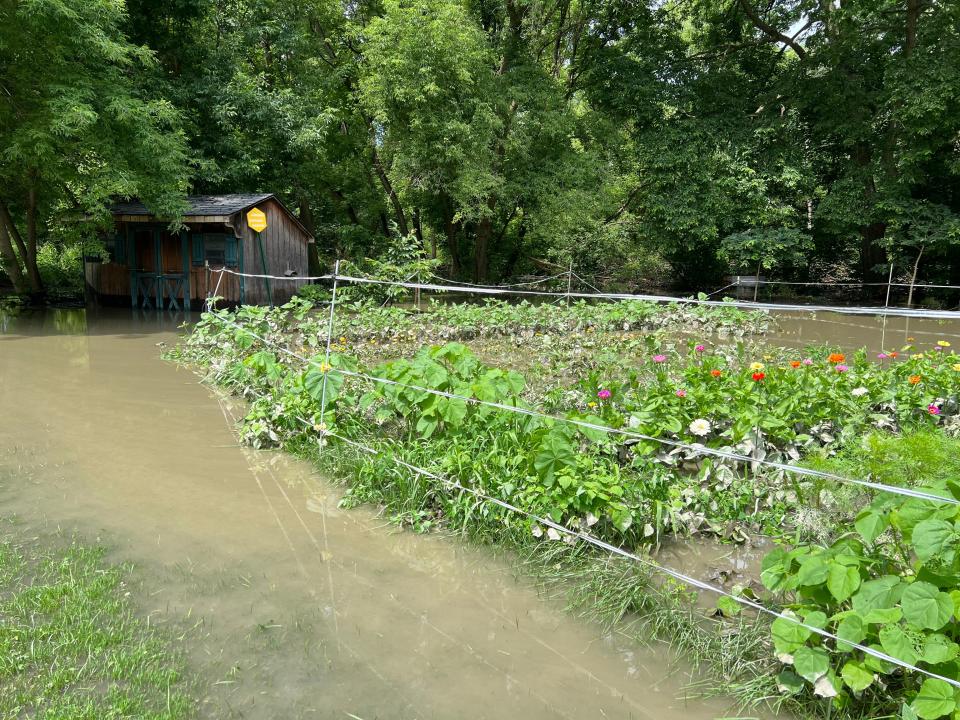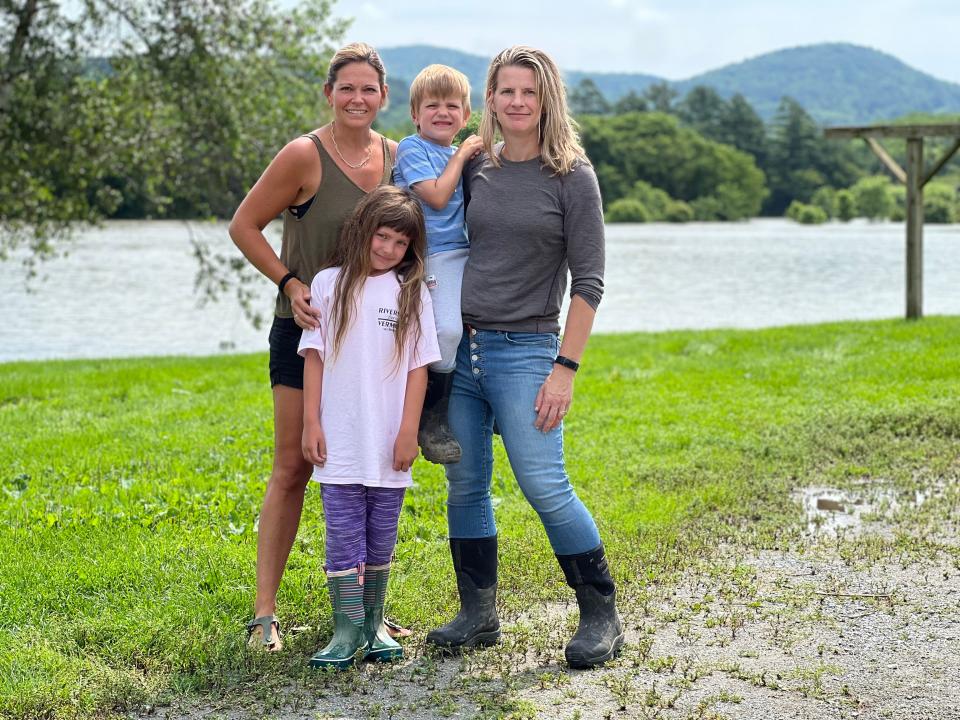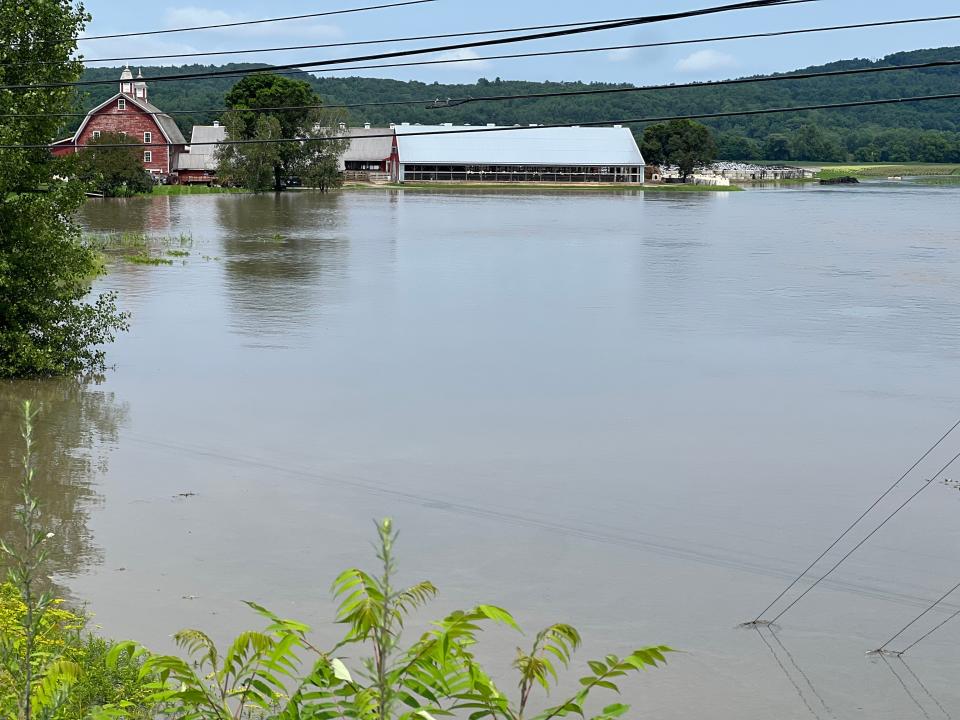Flooded fields leave Vermont farmers with major crop loss
COLCHESTER ― Normand Thibault and Jeff Senisac only have a few minutes to talk. The days following the floods are busy – hurrying up with damage control but waiting for the water to go down, tending to the animals that don’t know what happened, that only know it's time to eat.
“It was looking good – the best crop I've seen in many, many years,” Thibault said, sitting at a picnic table on his family’s 104-year-old dairy farm. “And boom. It’s done."
The second week of July brought historic rain and subsequent flooding to Vermont, with some pockets of the state getting 9 inches of rain in the span of two days.
Thibault put $30,000 into his 110 acres of corn crops this year, located in the flood plains along Malletts Bay Avenue. His stalks are now knocked down and drowning in the Winooski River that ran into his fields during the storms. He explained that corn can’t go more than three days underwater before dying from oxygen deprivation.

Senisac used to be in the dairy business too, but now runs a sporting stable next door. He grows his own hay.
“I’ve got more than half of the first cut-hay I haven’t done yet. And that’s just going to be removed and disposed of,” Senisac said.
More: How to stay safe returning to a flooded home and what federal assistance is available.
Thibault and Senisac explained that even if some crops make it, with the soil deemed uncontaminated, the flood waters brought silt that will turn to dust all over Thibault’s corn and Senisac’s hay. The animals can’t ingest that. They say removing it might even damage their farming equipment.
Thibault is looking at a net loss of $70,000 to $80,000 for losing his corn crops, the money he put into his crop and the feed he’s going to have to buy elsewhere at a greater cost. Increased demand for feed to replace crops lost around the state during the storm is also a concern for Thibault and Senisac.

Many farmers find themselves in a similar situation to Thibault.
“This is their livelihood” Thibault said, when asked what he wants people to know about this situation. He speaks about farmers broadly and can't help but get teary-eyed; his words cut deep into his own situation, too. “But tomorrow is another day.”
Worse than Irene
That the impact of flooding is worse than 2011’s Tropical Storm Irene is a shared sentiment among many farmers – partly because of the storm’s duration, partly because of its timing.
“When we were looking at the forecasts over the weekend and even into early Monday, I just never thought it would get to the level where it was worse or even equal to Irene,” said Andy Jones, farm manager of the Intervale Community Farm in Burlington, on July 12 – two days after those rains brought unforeseeable damage.
With Irene, water flowed in and mostly out within 24 hours. This time the water kept building, and at an increasingly stronger flow. Irene hit in late August, nearing the season’s end for many farmers. This storm hit before many had the chance to begin harvesting.
“We had three months of harvests at sort of full throttle – June, July and August – before we got Irene and we had some of the storage crops like onions, and some of those other things, potatoes that we were actually able to harvest before the flood. And that just wasn't possible this year,” Jones said.
The Intervale Community Farm is the oldest and largest of the independent farms that comprise the Intervale, an agricultural neighborhood and natural farmland in Burlington's flood plains that spans 350 acres, owned and managed by the Intervale Center. Intervale Community Farm is a member-owned, CSA (Community Supported Agriculture) that runs through a consumer cooperative program.

About 40 volunteers showed up to the Intervale Community Farm when the flood warning came in, rushing to harvest all they could. To ensure the best, high quality produce, the farm uses continuous planting methods, meaning many crops were too immature to harvest, or won’t be ready until the fall.
The farm still lost 60-70% of its total output for the year, Jones said, adding it’s late enough in the season that replanting won’t be an option.
“Vermont’s growing season is short, and a historic flood in our limited window to grow food and crops is particularly devastating," Vermont Secretary of Agriculture Anson Tebbetts said at a press conference on July 14. Tebbetts described the floods as “the worst of the last century” and occurring during “the heart of our growing season.”
Jones said that repercussions on long-season crops grown in larger quantities such as potatoes, winter squash and onions is especially devastating.
Other independent farms in the Intervale such as Pitchfork Farm and June Farm faced 100% crop loss. New Farms for New Americans, a program of the Association of Africans Living in Vermont (AALV) that gives land and growing resources to refugees and immigrant families, lost seven months worth of food for the 100 participating families, according to an Instagram post on the organization's account on July 11.

Farmers are resilient, but hurting
The sun was shining and the waters sparkled as Alison Conant and family surveyed their farmland in Richmond the morning of July 11. The day would have been glorious if not for the fact that nearly 300 acres of crops were now a lake. A dairy barn full of cows was spared, the slightly higher ground a new peninsula jutting out where waters had come to within 30 feet of the stalls.

Conant has learned to look on the bright side – all the people, animals and structures were safe following three inches of rainfall in Richmond in less than two days that caused the Winooski River to spill over its banks into fields of hay and corn.
They are farmers, by nature resilient, and they had a number of contingency plans that included transporting truckloads of cows if needed. Fortunately they didn’t have to use them.
“This is a tough day for sure as we look out across these flooded fields, but we know it will be OK – we’re not going anywhere.”
Conant’s Lakeside Farm has been in Alison’s husband’s family since 1854 and they have weathered countless storms, including Irene in 2011.

“We are right beside the river, which means we have beautiful soil to farm in and sometimes we have stuff to reckon with with the river."
Flood plains are great for agriculture, Conant said, not just because of the soil. Structures aren’t allowed to be built there, so many farms across the state use them for planting.
“Everybody is feeling a little concerned this morning and wondering what it's going to look like when the water recedes and hoping it does so quickly,” Conant said. She wasn’t ready to guess whether the crops would be salvageable or what the total damage and impacts would be, saying it’s better not to get caught up in the what-ifs and instead focus on the reality.
Much of the community buys their sweet corn from the farm. Conant said they have been very supportive, quick to call or send texts, and other farms reached out to make sure they were OK.
“The reality is things are changing and we need to be able to be flexible and resilient in the face of more and more extreme weather,” Conant said.
Years ago the cows could walk right up to the river. Over time, the family planted trees along the bank of the Winooski River to prevent erosion. The farm also uses cover crop between harvests and they no longer spread manure as fertilizer but inject them instead. These conservation efforts are meant to lessen the impacts of flooding on the farm and improve the health of the river when it does.
“Certainly a lot of hard work goes into all of this and you never want to see setbacks, but it is just a reality of farming that there are going to be setbacks sometimes,” Conant said. “We’re proud that we’re still here and still doing it.”
River runs two ways, effects on soil
Conant and Jones both pointed out the irony of the situation: what has caused these farms to flood also is the foundation of their existence and success.
Robert & Normand Thibault Dairy Farm, the Intervale, and Conant’s Riverside Farm are all situated on flood plains along the Winooski River, farming fertile soil.
“The soil is there because of the flooding. It’s 10,000 years of sediment being deposited by the river that has led to these flat expanses of stone-free, sandy, easy-to-work soils that are some of the most productive soils in Vermont,” Jones said. “Floodplains are some of the most productive soils anywhere. And the downside is they flood.”

For this reason, Jones isn’t concerned about long-term soil impacts, just short-term ones. After Irene, Intervale Community Farm tested their soil and found no evidence of contamination. Since their produce has simply been lost this time, contamination isn’t the concern.
Tebbetts said that dairy farmers should test their soil and crops to determine if anything can be salvaged. Dr. Heather Darby, an agronomy specialist and extension professor at University of Vermont, will be conducting testing through her agronomy lab.
Compounding factors
In late May, farmers took a hard hit when temperatures dropped to 20 degrees one night, killing off fruit that had just started to grow. Jones said luckily only their strawberries were really affected by the late-spring freeze, taking about 50% of the crop.
Extensive damage from the hard freeze do not come close to the damages caused by the floods for farmers, yet demonstrate the financial scale of the catastrophe.
More: May's hard freeze Vermont orchards and vineyards devastated by late-May freeze: 'So powerless to protect it'
“We believe the loss for our growers was about $10 million during the May freeze,” Tebbetts said. If farmers are to receive financial compensation for the freeze in the form of direct payments, Congress will need to allocate money for that, he said.
Farmers in New Hampshire, Connecticut, New York and Massachusetts have been impacted as well – both by the hard freeze and the flooding. Tebbetts said the breadth of devastation across the region will help quickly garner federal aid to help relieve the financial losses that farmers will bear following the floods.
Tebbetts said his greatest concern is produce loss, as the water covering thousands of acres of crops will amount to the greatest damage.
Dairy farmers, like Thibault, are suffering the loss of corn crops but have also been affected by road closures, Tebbetts said.
Cows need to be milked twice a day. Their milk goes into holding tanks for storage and must be transported to creameries. Pick-up times can vary and farms do not have a huge capacity to keep milk cool for an extended period of time. Road closures due to flooding onto streets jeopardizes the day’s milk.
Though Thibault wasn’t particularly impacted by the freeze or road closures, he feels dairy prices are additionally putting him out.
“Milk is crashed so bad right now. So it's a double whammy, you know, milk can cost below the cost of production,” he said. The baseline financial stress of the dairy industry is making the financial loss of his crops feel even greater.
Such drastic losses for a backbone of Vermont’s culture and economy will have lasting repercussions extending outward from individual farmers to the regional food systems.
On July 14, Sens. Bernie Sanders and Peter Welch, and Congresswoman Becca Balint, sent a letter urging Agriculture Secretary Tom Vilsack to approve Gov. Phil Scott's request for a secretarial disaster designation pertaining to Vermont's farms and rural farming communities.
“They love their land, but they are hurting, like the thousands of Vermonters who have lost their homes or businesses," Tebbetts said about farmers. "Farmers feed us and will continue to feed us. Let’s do our part to support them as we navigate this historic event with them."
Resources for farmers
Tebbetts advises farmers to contact their insurance agents, so Vermont Agency of Agriculture Food and Markets can gather information to present to federal partners, such as the USDA and FEMA. The Vermont Agency of Agriculture has compiled a list of resources for farmers at https://agriculture.vermont.gov/flood.
Places to donate to support farmers
Many farms, such as Intervale Community Farm, are still in the damage assessment phase. Until people begin explicitly asking for volunteers and have the bandwidth to organize those efforts, try to focus efforts elsewhere.
Donate to the Intervale Recovery Fund at www.intervale.org/donate.
Donate to the Northeast Organic Farming Association of Vermont at www.nofavt.org/donate-now and select “Farmer Emergency Fund” under “Campaign.”
Donate to Center for Agricultural Economy’s Vermont Farm Fund at tinyurl.com/CAEvtfarmfund.
Donate to New Farms for New Americans at aalv-vt.org/donate.
Other ways you can help
Start with places in your community that have been impacted by the flooding.
Buy local produce, meat and dairy products from local farmers.
Attend farmers' markets, such as the Burlington Farmers Market on Saturdays from 9 a.m. to 2 p.m., where farmers might be trying to sell the last of their produce.
Contact Kate Sadoff at ksadoff@gannett.com. Contact reporter April Barton at abarton@freepressmedia.com or 802-660-1854. Follow her on Twitter @aprildbarton.
This article originally appeared on Burlington Free Press: Vermont flooding: Farms suffer more damage and loss than during Irene

